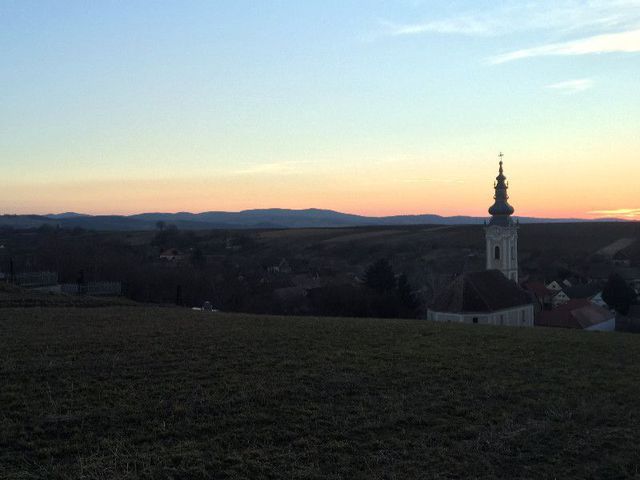Warning: as the title suggests, this post contains pictures of dead animals and unprocessed meat. If this makes you uncomfortable, I advise you not to go further and skip this blog post.
A downside of living off-grid is that it is very rare that you can leave the homestead unattended for extended periods of time. We never leave during spring or summer, the growing season being so short and busy. Fall is the peak of harvest season, making it impossible to travel anywhere. And in the middle of winter, even though we don’t have any plumbing inside the house, all the harvests we canned would be put in jeopardy with no automatic heating system to keep the house above freezing. Finding care for animals is always challenging. Therefore, we rarely travel together as a family, enjoying instead picnics on the land, or quick getaways at a nearby pond.
My husband and I both immigrated from Europe, so when the time comes to visit family we take turns taking our son overseas to see family. In my case, the last time I have set foot in Belgium was 7 years ago, and twice as long in Hungary where the majority of my extended family is. This year, I decided to finally do two things I have put off for too many years: apply for my American citizenship and go to Europe. Both are now fulfilled (more on the American citizenship later). I will skip telling you about the trip to Belgium, which was great but pertains not to homesteading. Instead, let me bring you to Hungary, land of paprika, goulash and healing waters. Besides seeing family members and reminisce about our past, I wanted to learn the Hungarian way of preserving meat. I have learned a lot from my aunts over the many summers I have spent there as a child. How to can, how to garden, how to process chickens, ducks, and, yes, pigeons. One thing I remember vividly from my childhood was the ‘Disznovagas’ (butchering of the pig), which is an all day event, where family and neighbors gather to butcher the family pig. This is usually done in the winter months, when flies are not around, as they would compromise the smoking process. In the past, they would smoke and cure the whole pig. Communism, which ended in Hungary in 1989, forced people in rural areas to be creative with their limited resources. My family, even though very poor at the time, never lacked food on their table. They raised their meat and grew their vegetables. A root cellar was all they had to preserve the fruits of their labor. Even though they now have fridges and freezers, the older generation continues their traditional method of preserving meat. It is becoming a lost tradition, a trend that I have also witnessed in Vermont with the professionalization of butchering.
My family kindly made arrangements for me to participate in two butcherings so I could get some hands-on practice to take back home.
Pictures of the butcherings and what I learned along the way:
We started both butcherings days at 8 am, with Palinka (homemade fruit spirit) and food. 4-5 shots were given throughout the day. It is, after all, not just hard work, but also a social event. The cold weather and hours of standing require boosts of energy, which Palinka delivers fast.
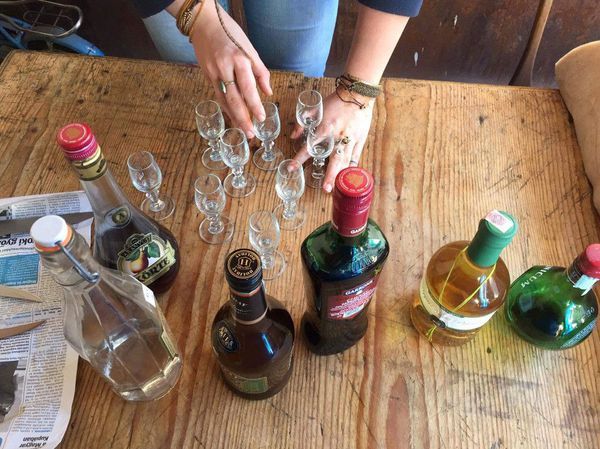
Beginning

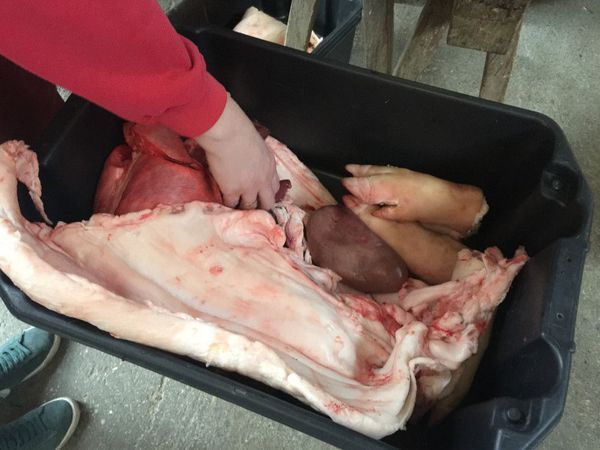
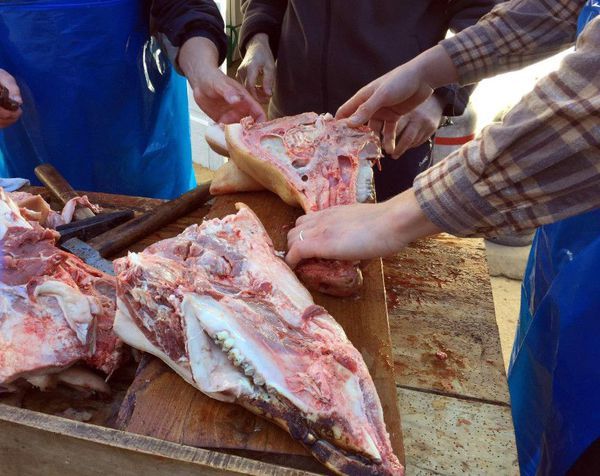

Because this was not my family’s first butchering this year (it was their third one), the pig was brought already slaughtered. The pig was already cut in big pieces too. Meat, organs, and blood were delivered a few hours after the pig’s death.
Turning offal and head into food
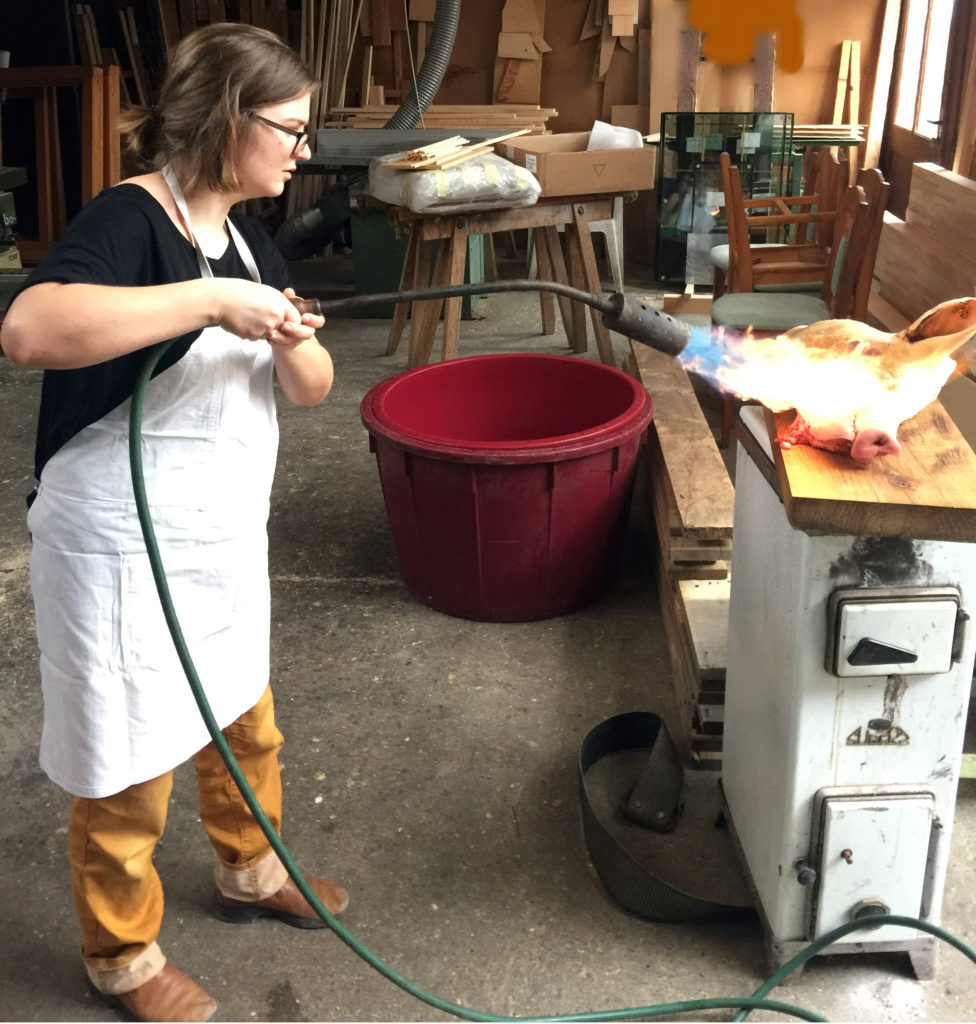
My son, witnessing his first pig butchering.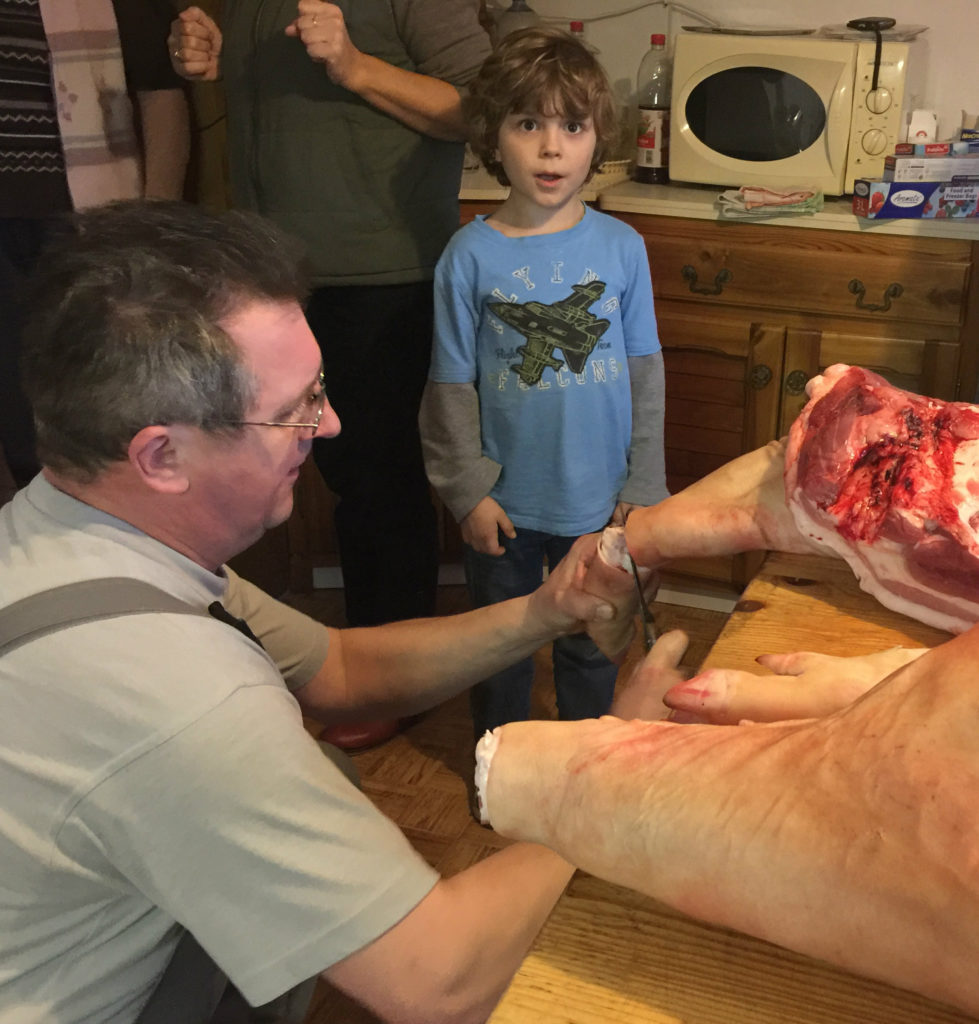
We started working on the head and organs first, outside. I flame torched the head to remove all hair, which was done also on the body. I then proceeded to remove part of the ear, part of the snout, and eyeballs; these were the only parts discarded. The head and organs were then put in a pan outside and boiled for 4-5 hours, while we were working on the meat inside the house. As we worked on the pig inside, we kept adding some skin, feet, and fat to the outside pot.
Cutting and trimming the meat
Chuck roasts, ribs, ham: the good cuts. These will be frozen or given to friends.
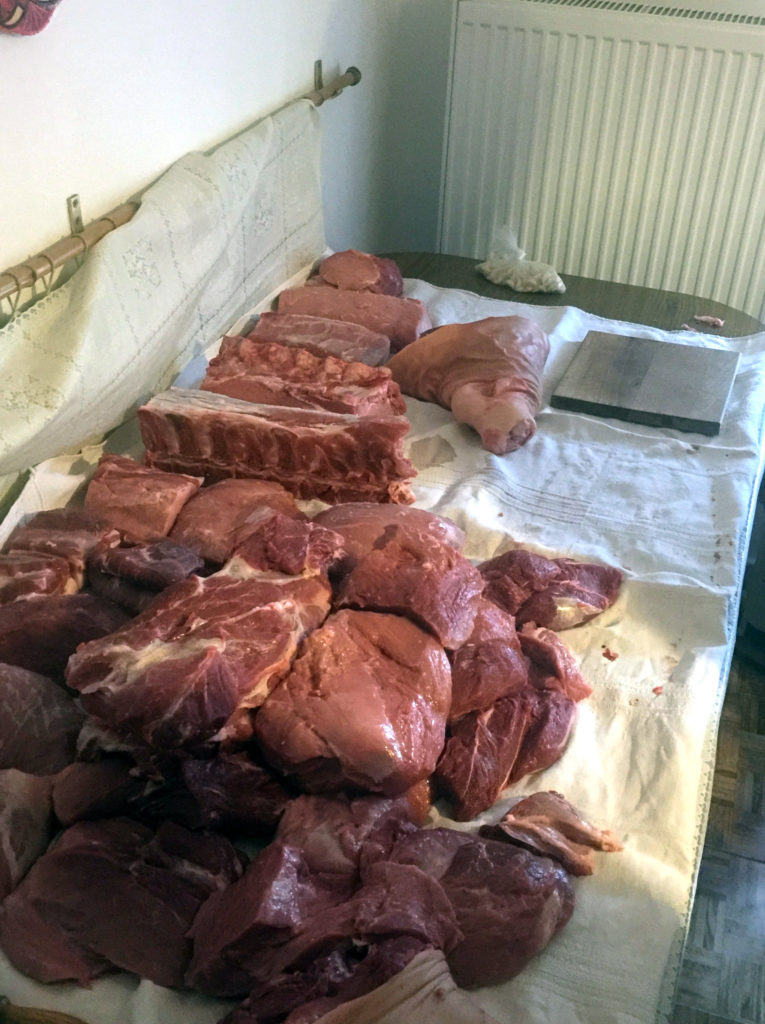
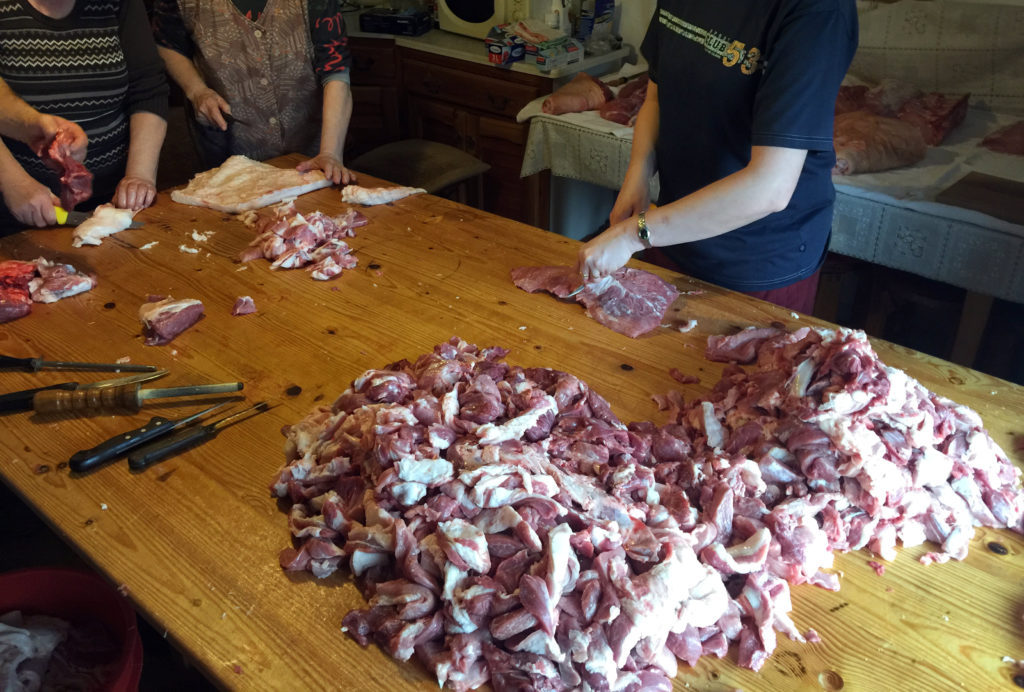
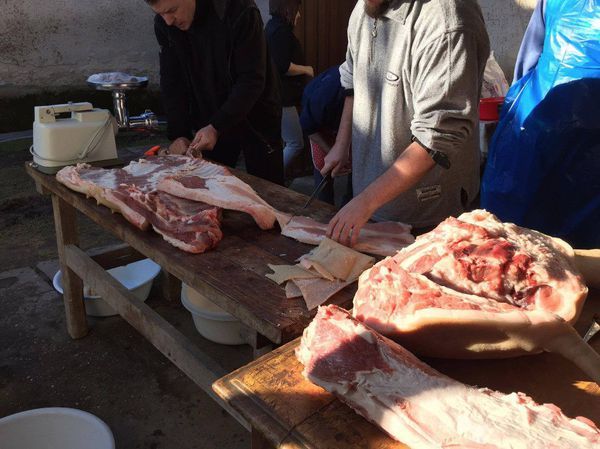
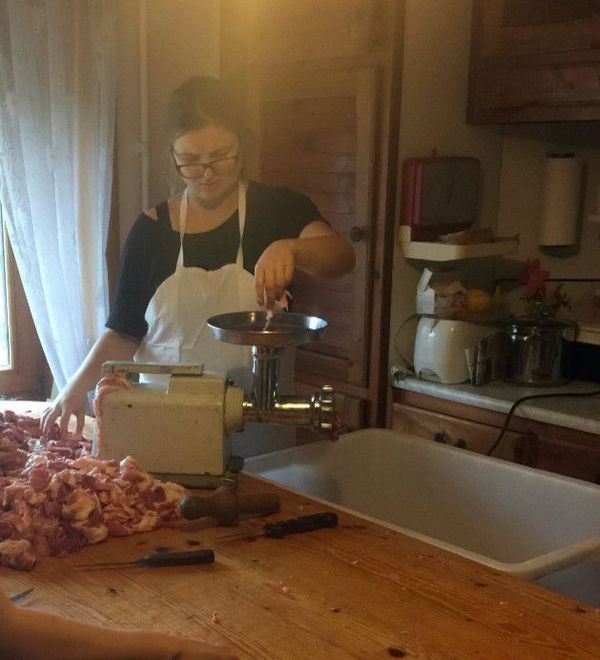
Inside, we worked on trimming the fat from the meat, keeping some parts for roasts that will be used later. I asked what they would have done back in the days with those cuts. My aunts said that those good cuts would have been given to the families that came to help, some would be kept for a big family dinner the day after. And the rest would be turned into Kolbasz (dried sausages) or Szalami (salami).
It was getting too warm to make bacon or ham, the meat would need to be hung for up to 10 days to fully cure, and the weather was getting too warm to make it safe to eat. They showed me how to cut the parts, but we turned them into Szalamis. The rest of the day was spent cutting big pieces of meat and fat into small pieces to feed to the meat grinder. This was done in the past by hand crank meat grinders, which they said would take hours.
Steps to make cooked sausages using the organs, feet, and head
Cooking outside for 5 hours, in a cauldron on an open fire.
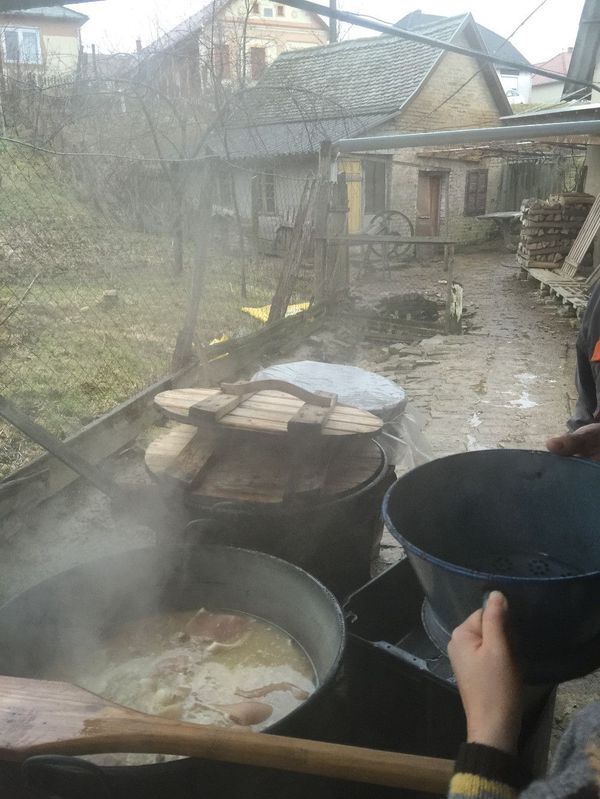
Boiled meat, organs, and skin put outside to cool down
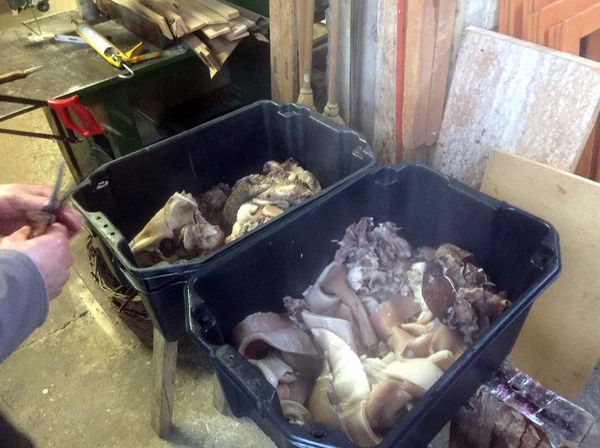
We checked on the boiling head, skin, and organs a few times outside. Once fully cooked, the meat was removed from the broth outside to allow it to cool before turning them into Hurka (sausages) and Veres Hurka (blood sausages). Once the meat and organs were removed from the broth, a few veggies were added to the pot (carrots, onions, and garlic). Once the sausages assembled, they were put back in that broth to allow some of the fat to come out for 30-60 minutes. In the old days, they would drink this broth during the day, add more vegetables and some pasta to make it a meal. The advantage of these sausages is that they can be eaten right away, can be stored in a root cellar, and they use all the parts of the pig that might not be desirable on their own. They are also, of course, delicious.
Making Szalami (salami), Kolbasz (dried sausage), Hurka (cooked sausage), and Veres Hurka (blood sausage)
The casings for the Szalami and Kolbasz/Hurka (sausages) are made using the intestines. They are thoroughly washed, then salted to be stored. Once ready to use, it is washed again with water and lemon juice.
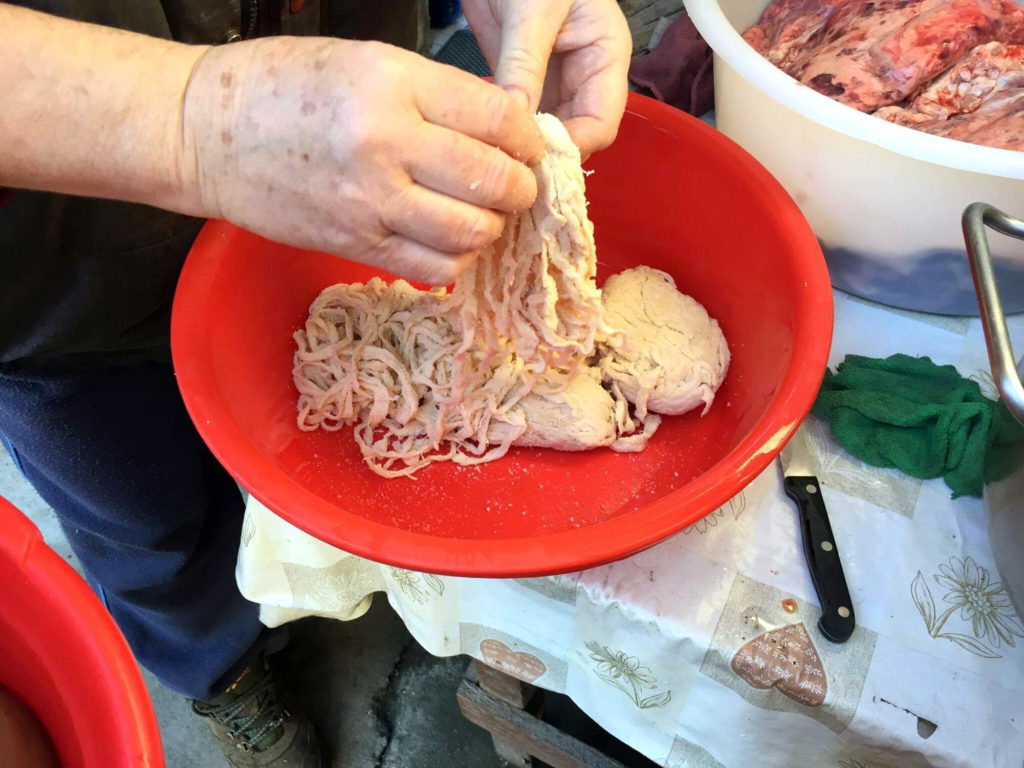
A few cups of garlic prepared the day before.
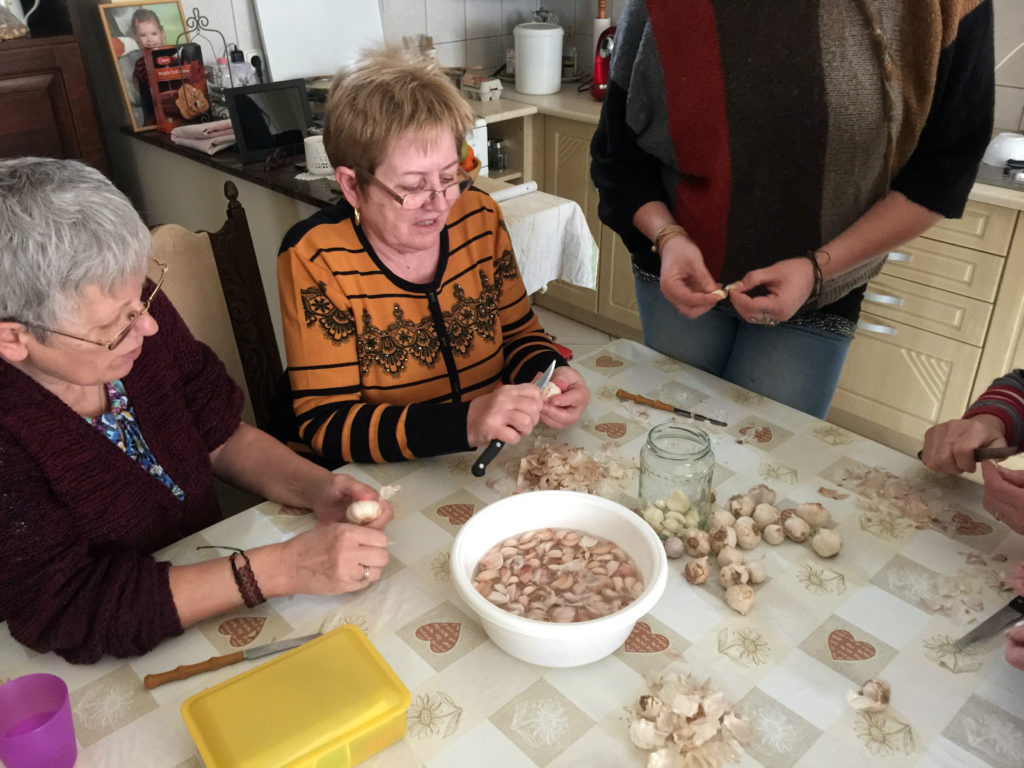
Organs, skin, fat, and meat from the head. A few cups of rice, paprika, salt, and garlic are added. And…
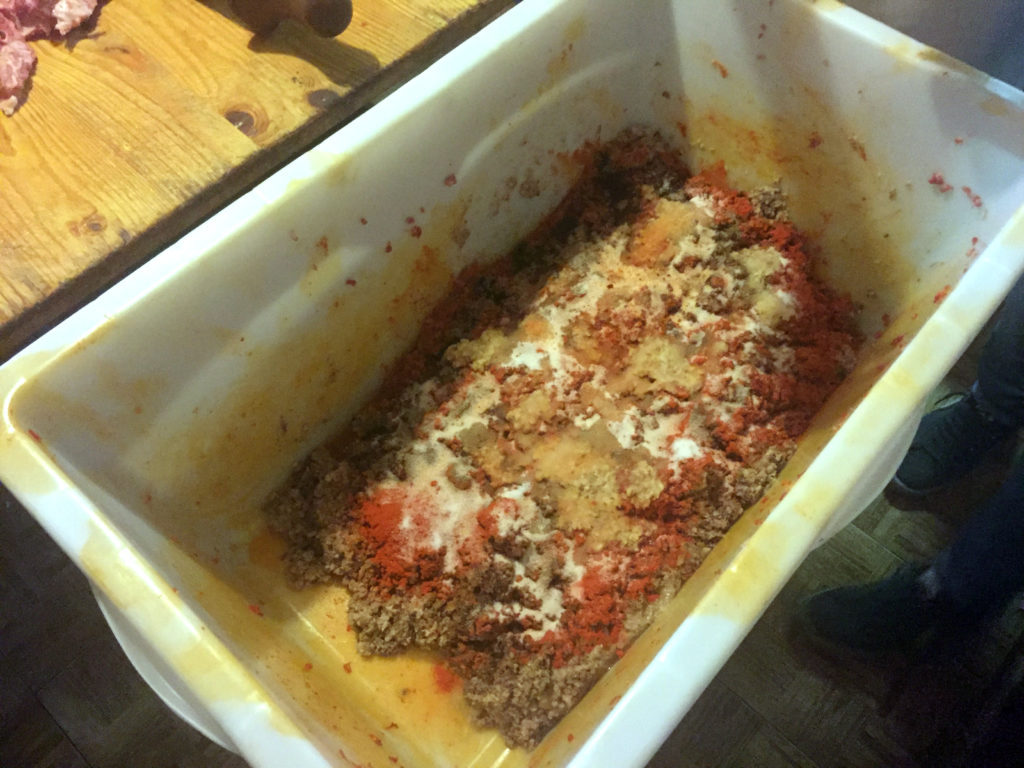
will become these. They will be cooked again in the broth for another 30-60 minutes and will turn into…
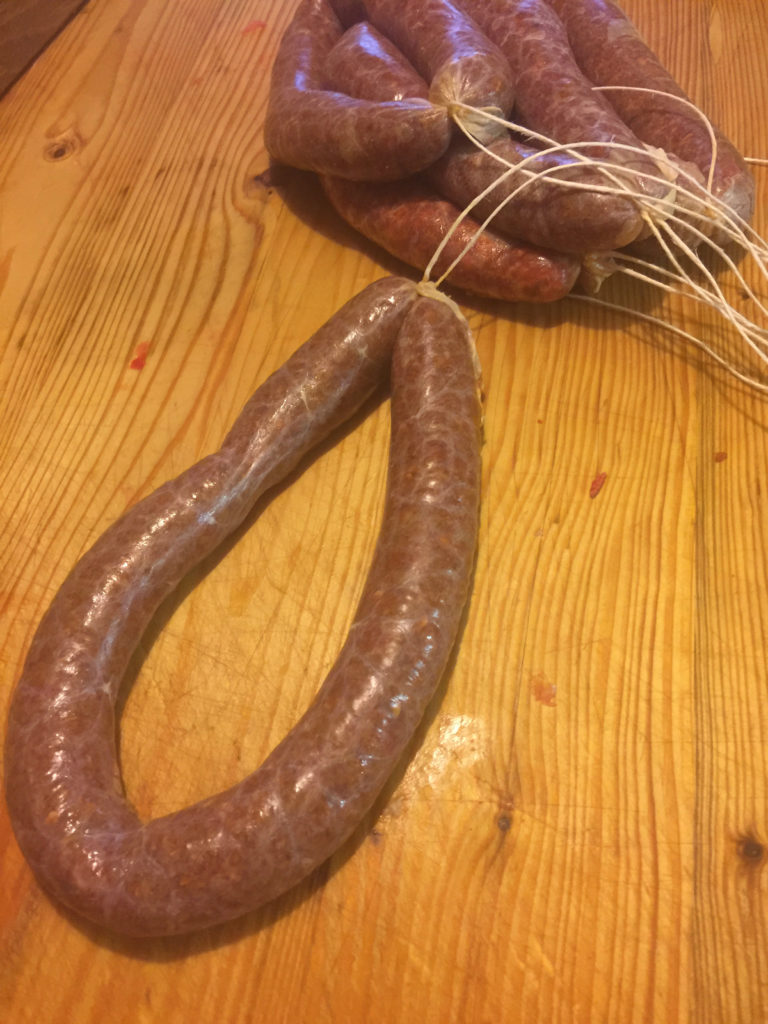
these. Once cooled off, they are now ready to be hung in the root cellar or to be eaten right away.
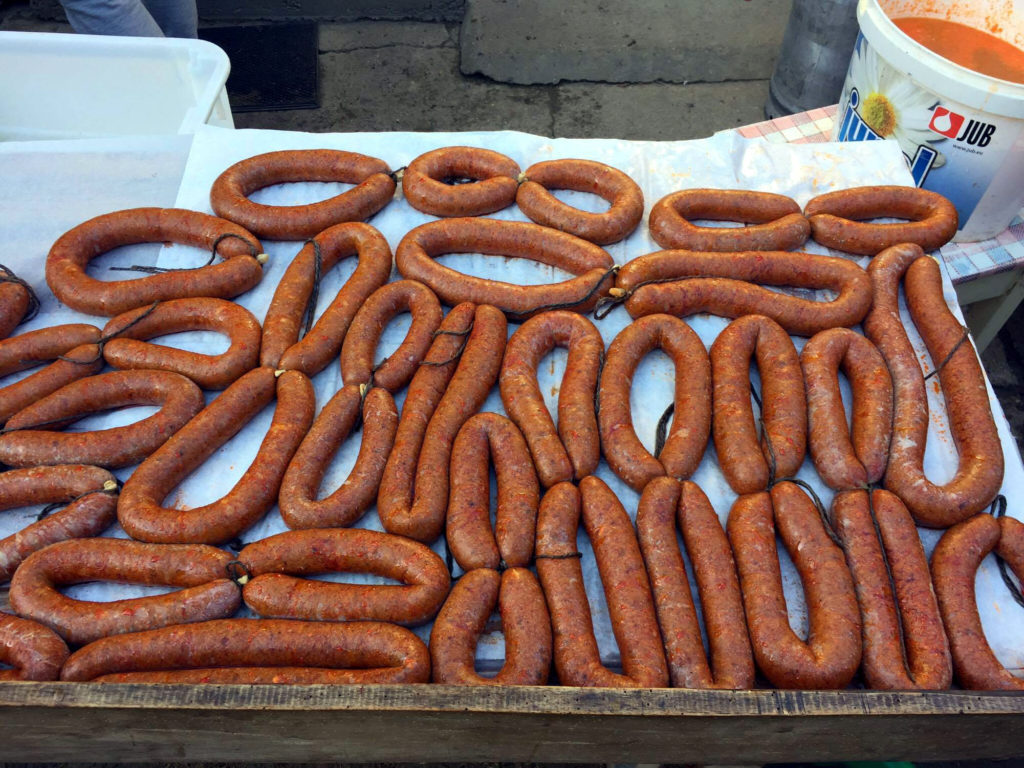
A portion of the head/organs mixture will also be used for blood sausages (Veres Hurka). The coagulated blood is added to the mixture…
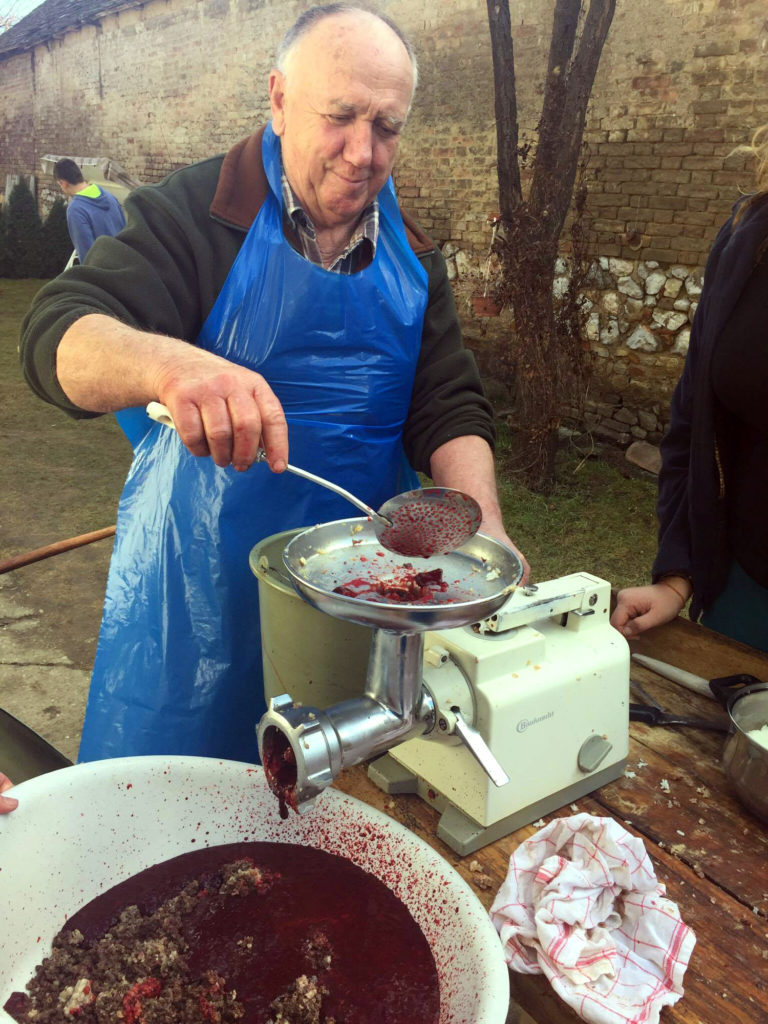
mixed by hand…
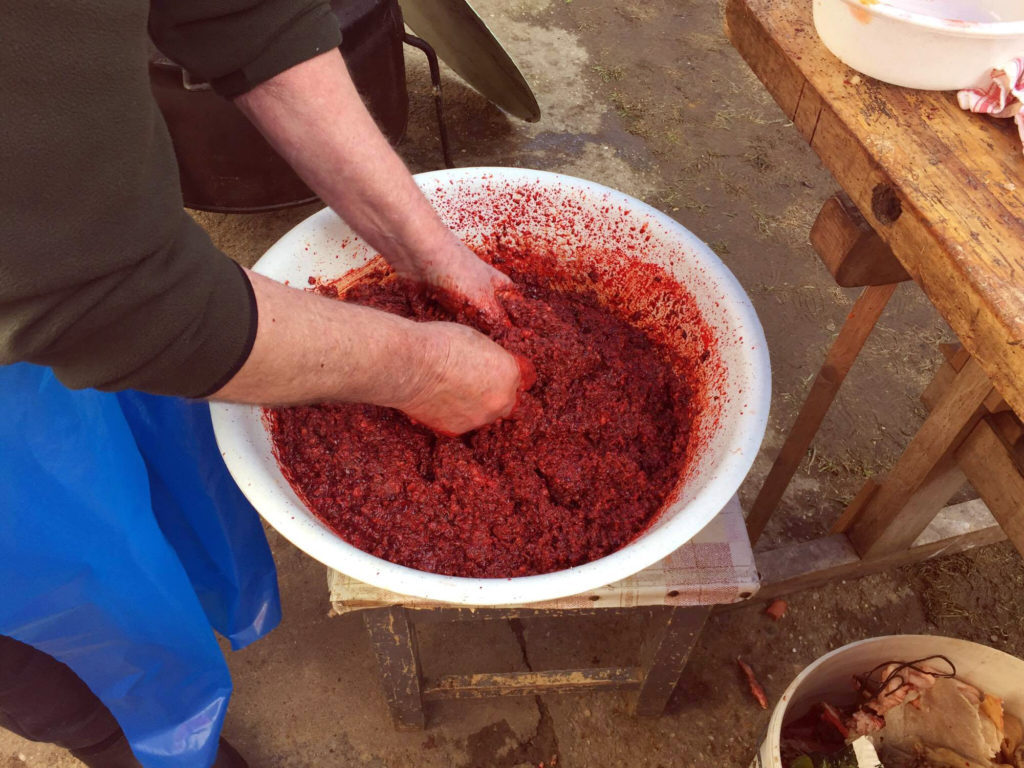
and put through casings. They will also go back to the broth for an hour and will be ready the same day to be eaten.
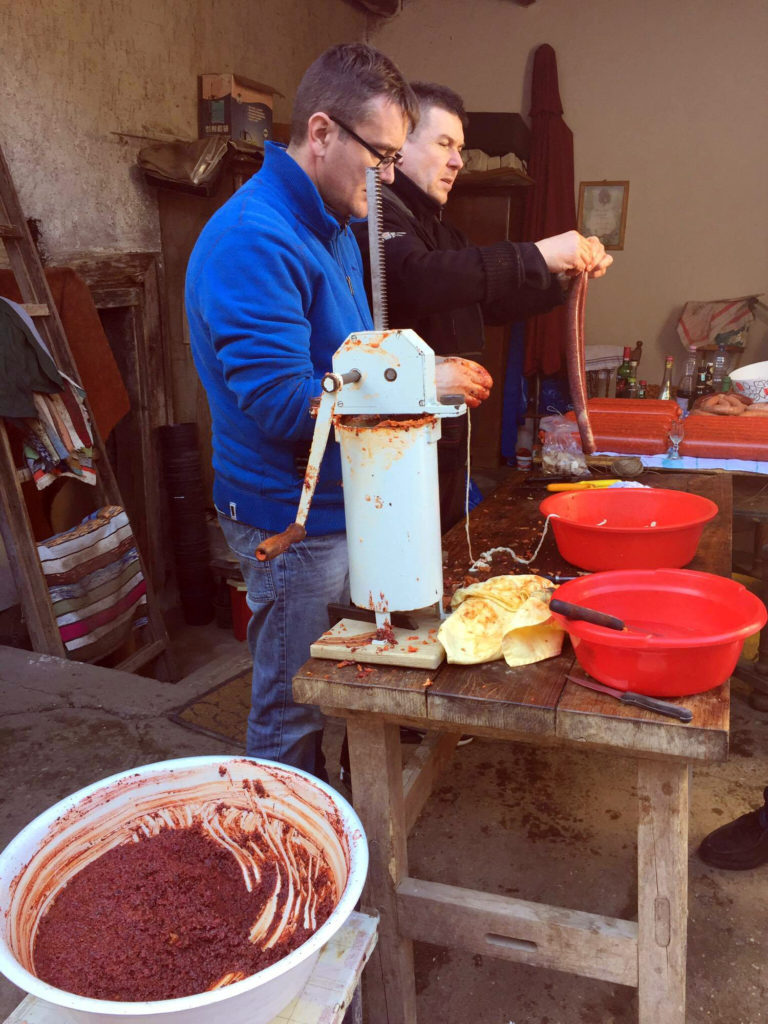
These are the Kolbasz, the sausages made out of the good cuts of meat. They added paprika, garlic, and salt to the raw meat. They will be smoked from cold smoke for 3 days (and turned every day to allow for smoke to touch every part of the sausage), and will then age and dry in the root cellar for several weeks.
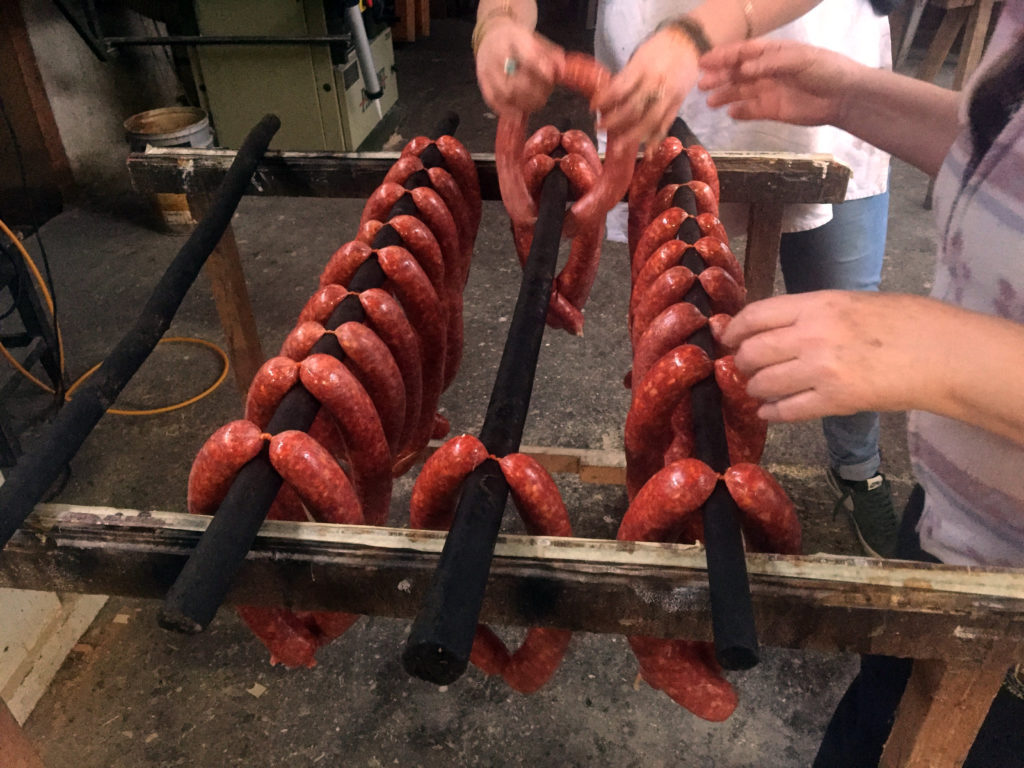
After several weeks in the root cellar, the Kolbasz can be eaten.
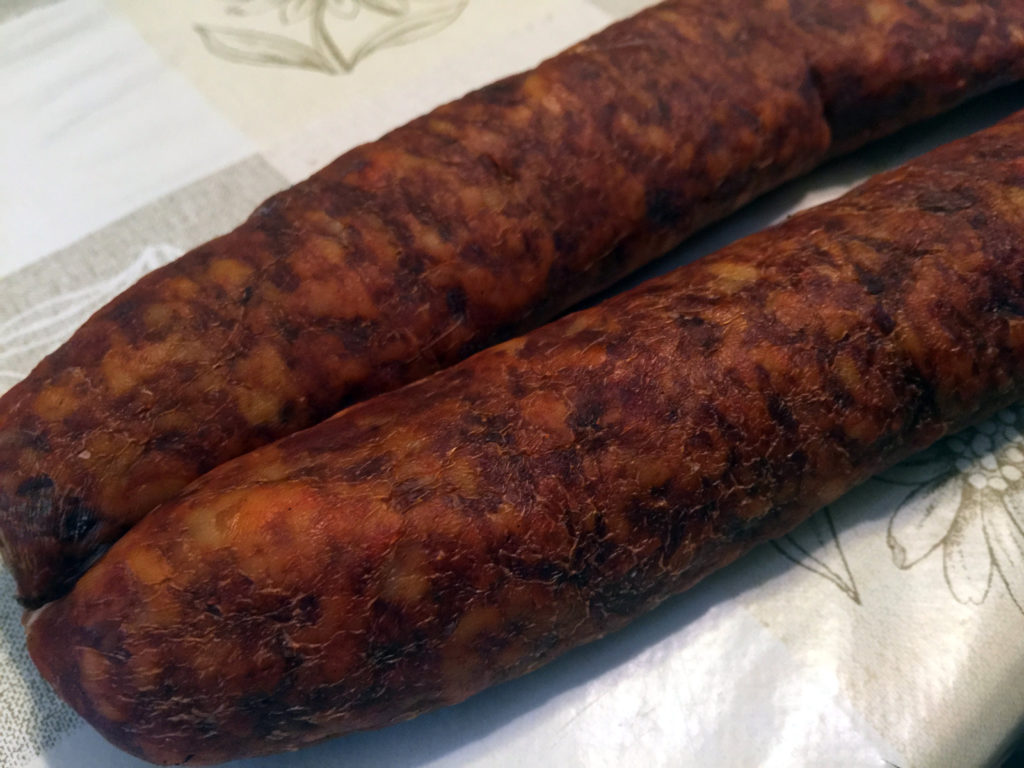
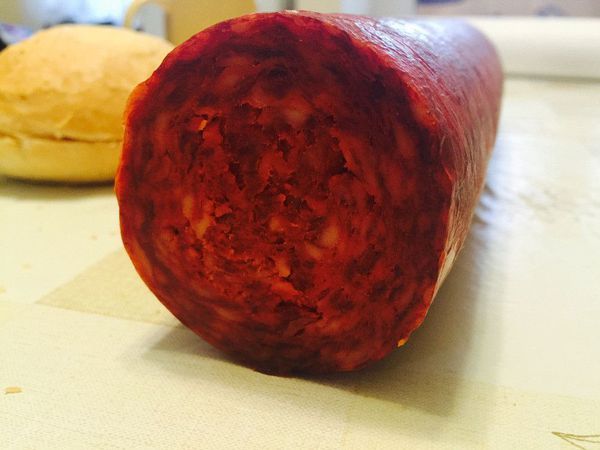
The Szalami has the same ingredients as the smaller version, the Kolbasz. The difference is the size and the casing used (collagen casing in this case), it is about 3 inches in diameter. Also, there is no garlic in the Szalami. The consistency is, therefore, not as firm, the inside hasn’t had time to dry as much as the Kolbasz. It is also hung in the smoking room for 3-4 days, and can be eaten after a drying time of 4 weeks (the one shown in the picture is 4 weeks old, and is on the ‘young’ side, so more spreadable).
The Szalami and Kolbasz (Hungarian dried sausage) was the reason I wanted to witness a Disznovagas. I thought it would be very complicated and would require a certain technique that could only be found in this part of the world. It was actually the easiest part. Put meat in a grinder, add spices, mix for 45 minutes by hand, taste (yes, taste raw meat), put through a casing, hang fro 2-3 days. Done. I kept pressing them for details. Surely I must be missing a secret step that makes this sausage so hard to find outside of Hungary. They told me it’s the quality of the garlic and the homemade paprika, something you can’t find outside of Hungary, or so they say.

My aunts wouldn’t let me leave without enough homemade paprika to share with friends back home. As you can see in this unedited image, the paprika is more vibrant and grounded into a finer powder than what you can find in the US.
The smoking room
It was hard to take pictures of the smoking room. As you can see, it is just a dark room, about 8*8 feet.
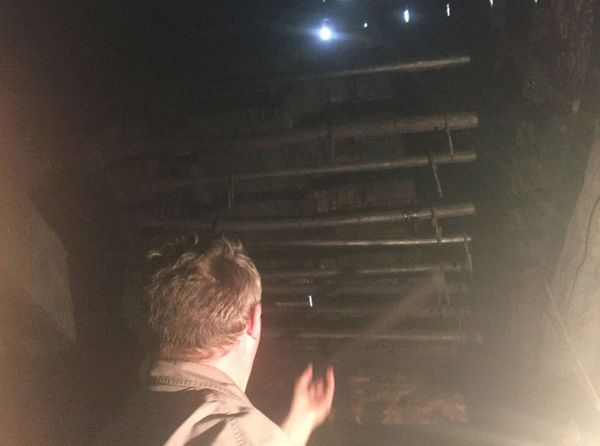
Container on the ground to contain the sawdust in one place. In my aunt’s smoking room, they only have a small pile directly on the concrete floor.
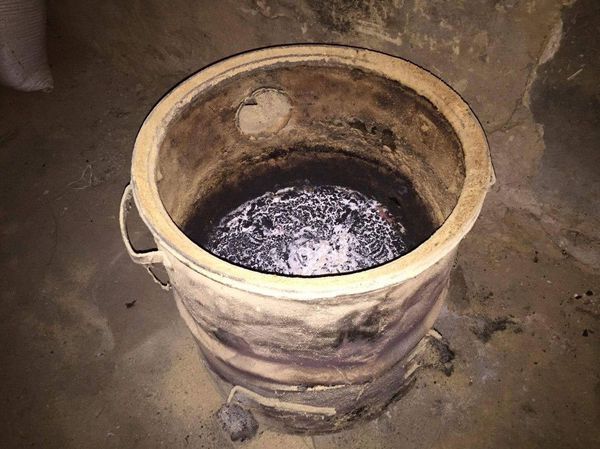
My husband sent me with a request: take plenty of pictures of their smoking room. He wanted to make sure he could recreate something similar in Vermont. I was again, fairly amazed at how simple it was. It was just a dark room, somewhat insulated (a few had holes in their roof and had water leaking), with a concrete flooring. The smoke comes from hardwood sawdust (produced by a hand sawing to avoid oil residue), and the smoke is cold. No open flames. They start a small fire on day one, add the sawdust (about a big scoop), and let the smoke fill the room. Once or twice a day, they add a big scoop to the pile. They repeat this for a few days (10 days for bacon and ham, 3-4 days for Szalami and 2-3 days for Kolbasz). The only thing that they told me to be careful about was to make sure the wood rods that hold the sausages are high enough from the ground, and not reachable by mice.
Using every last bit
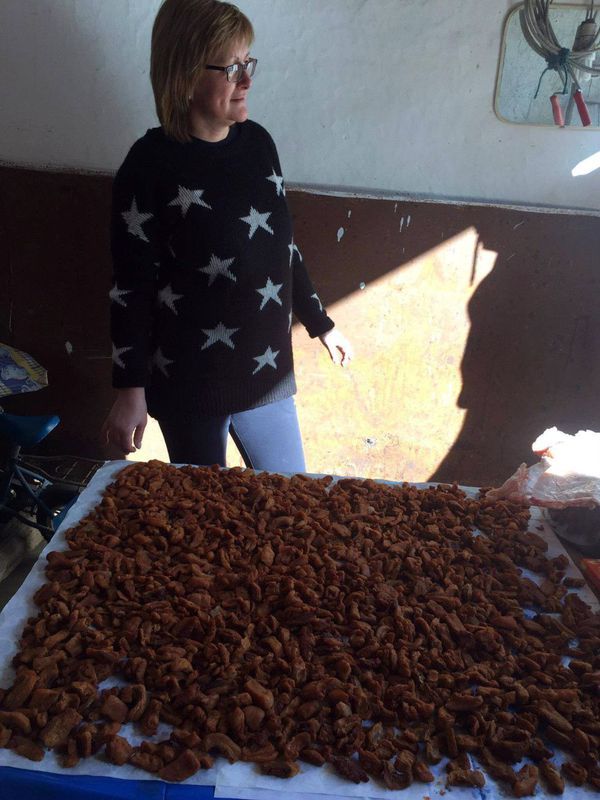
Hungarians use a lot of lard to cook and bake. My family also eat a lot of Toportyu (pork crackling NOT pork rind, which is fried skin). And if you never had pork crackling, you are missing out. It sounds completely disgusting (fried fat…), but it is something out of this world when fresh. To make it, they cut the fat into 1-inch pieces. My cousin likes to leave a little bit of meat on some of them, to add flavor. Those pieces are then put in a cauldron outside on an open-fire, and cooked down for 1-2 hours, stirring almost constantly (that’s when the Palinka starts flowing for the lucky person who is stirring). When the Toportyu is almost done, once it starts to brown, they add a glass of milk to the pot and cook for an extra 10 minutes. They remove from the heat and sprinkle with salt. These will be eaten as is during cold days or mixed into Tepertos Pogacsa (very flaky biscuit that uses those cracklings). The grease/lard left in the pot could be used to make soap (something they don’t do, they add it to their compost pile).
Recipe to make Szalami or Kolbasz:
- 10 kg (22 lbs) of a mixture of fat and meat (30% fat max.)
- 240 gr. (1/2 lb) salt
- 200 gr. (0.44 lb) paprika
- 50 gr. (2 tbsp) hot paprika
- 20 gr. (1 tbsp) pepper
- 30 gr. (2 tbsp) crushed garlic (my cousin recommended letting the garlic sit in a few tbsp of water and then sprinkling that mixture on the meat). (No garlic for salami)
Mix by hand for 30-45 minutes (take turns with someone, this is hard work.) Once the meat doesn’t stick to your hands anymore, it’s ready. Put in casings (small casings for Kolbasz), hang for 3 (Kolbasz)-4 (Szalami) days in a smoking room with cold smoke. After 3-4 days, move to a cool and dry area for several weeks to dry.
——————————————————————————————-
It was an eye-opening experience to go back to a country that holds many childhood memories. I found that those memories are very similar to the life I am now living. Raising animals for meat consumption is a step we have taken with poultry, but not with larger animals. After this trip, we want to pursue that path, knowing that the whole animal will be used, and nothing will be wasted.
Do you raise pigs? What has been your experience with the butchering process? Do you use 100% of the animal for consumption?
